Related Research Articles
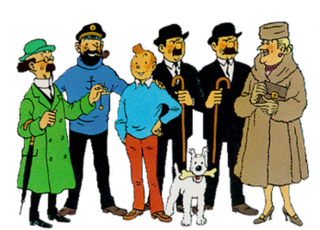
The Adventures of Tintin is a series of 24 comic albums created by Belgian cartoonist Georges Remi, who wrote under the pen name Hergé. The series was one of the most popular European comics of the 20th century. By 2007, a century after Hergé's birth in 1907, Tintin had been published in more than 70 languages with sales of more than 200 million copies, and had been adapted for radio, television, theatre, and film.
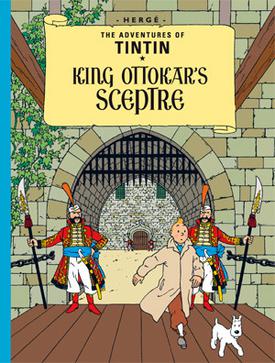
King Ottokar's Sceptre is the eighth volume of The Adventures of Tintin, the comics series by Belgian cartoonist Hergé. Commissioned by the conservative Belgian newspaper Le Vingtième Siècle for its children's supplement Le Petit Vingtième, it was serialised weekly from August 1938 to August 1939. Hergé intended the story as a satirical criticism of the expansionist policies of Nazi Germany, in particular the annexation of Austria in March 1938. The story tells of young Belgian reporter Tintin and his dog Snowy, who travel to the fictional Balkan nation of Syldavia, where they combat a plot to overthrow the monarchy of King Muskar XII.

The Red Sea Sharks is the nineteenth volume of The Adventures of Tintin, the comic series by Belgian cartoonist Hergé. The story was initially serialised weekly in Belgium's Tintin magazine from October 1956 to January 1958 before being published in a collected volume by Casterman in 1958. The narrative follows the young reporter Tintin, his dog Snowy, and his friend Captain Haddock as they travel to the fictional Middle Eastern kingdom of Khemed with the intention of aiding the Emir Ben Kalish Ezab in regaining control after a coup d'état by his enemies, who are financed by slave traders led by Tintin's old nemesis Rastapopoulos.

Tintin and Alph-Art is the unfinished twenty-fourth and final volume of The Adventures of Tintin, the comics series by Belgian cartoonist Hergé. Left incomplete on Hergé's death, the manuscript was posthumously published in 1986. The story revolves around Brussels' modern art scene, where the young reporter Tintin discovers that a local art dealer has been murdered. Investigating further, he encounters a conspiracy of art forgery, masterminded by a religious teacher named Endaddine Akass.
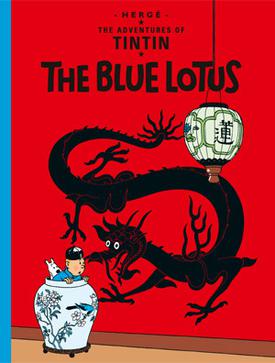
The Blue Lotus is the fifth volume of The Adventures of Tintin, the comics series by Belgian cartoonist Hergé. Commissioned by the conservative Belgian newspaper Le Vingtième Siècle for its children's supplement Le Petit Vingtième, it was serialised weekly from August 1934 to October 1935 before being published in a collected volume by Casterman in 1936. Continuing where the plot of the previous story, Cigars of the Pharaoh, left off, the story tells of young Belgian reporter Tintin and his dog Snowy, who are invited to China in the midst of the 1931 Japanese invasion, where he reveals the machinations of Japanese spies and uncovers a drug-smuggling ring.

Tintin in America is the third volume of The Adventures of Tintin, the comics series by Belgian cartoonist Hergé. Commissioned by the conservative Belgian newspaper Le Vingtième Siècle for its children's supplement Le Petit Vingtième, it was serialized weekly from September 1931 to October 1932 before being published in a collected volume by Éditions du Petit Vingtième in 1932. The story tells of young Belgian reporter Tintin and his dog Snowy who travel to the United States, where Tintin reports on organized crime in Chicago. Pursuing a gangster across the country, he encounters a tribe of Blackfoot Native Americans before defeating the Chicago crime syndicate.

Flight 714 to Sydney is the twenty-second volume of The Adventures of Tintin, the comics series by Belgian cartoonist Hergé. It was serialised weekly from September 1966 to November 1967 in Tintin magazine. The title refers to a flight that Tintin and his friends fail to catch, as they become embroiled in their arch-nemesis Rastapopoulos' plot to kidnap an eccentric millionaire from a supersonic business jet on a Sondonesian island.

Tintin in Tibet is the twentieth volume of The Adventures of Tintin, the comics series by Belgian cartoonist Hergé. It was serialised weekly from September 1958 to November 1959 in Tintin magazine and published as a book in 1960. Hergé considered it his favourite Tintin adventure and an emotional effort, as he created it while suffering from traumatic nightmares and a personal conflict while deciding to leave his wife of three decades for a younger woman. The story tells of the young reporter Tintin in search of his friend Chang Chong-Chen, who the authorities claim has died in a plane crash in the Himalayas. Convinced that Chang has survived and accompanied only by Snowy, Captain Haddock and the Sherpa guide Tharkey, Tintin crosses the Himalayas to the plateau of Tibet, along the way encountering the mysterious Yeti.

Tintin in the Land of the Soviets is the first volume of The Adventures of Tintin, the comics series by Belgian cartoonist Hergé. Commissioned by the conservative Belgian newspaper Le Vingtième Siècle as anti-communist satire for its children's supplement Le Petit Vingtième, it was serialised weekly from January 1929 to May 1930 before being published in a collected volume by Éditions du Petit Vingtième in 1930. The story tells of young Belgian reporter Tintin and his dog Snowy, who are sent to the Soviet Union to report on Stalin's government. Knowing of his intentions, however, the secret police of the OGPU are sent to hunt him down.

Tintin in the Congo is the second volume of The Adventures of Tintin, the comics series by Belgian comic strip artist Hergé. Commissioned by the conservative Belgian newspaper Le Vingtième Siècle for its children's supplement Le Petit Vingtième, it was serialised weekly from May 1930 to June 1931 before being published in a collected volume by Éditions de Petit Vingtième in 1931. The story tells of young Belgian reporter Tintin and his dog Snowy, who are sent to the Belgian Congo to report on events in the country. Amid various encounters with the native Congolese people and wild animals, Tintin unearths a criminal diamond smuggling operation run by the American gangster Al Capone.

Red Rackham's Treasure is the twelfth volume of The Adventures of Tintin, the comics series by Belgian cartoonist Hergé. The story was serialised daily in Le Soir, Belgium's leading francophone newspaper, from February to September 1943 amidst the German occupation of Belgium during World War II. Completing an arc begun in The Secret of the Unicorn, the story tells of young reporter Tintin and his friend Captain Haddock as they launch an expedition to the Caribbean to locate the treasure of the pirate Red Rackham.
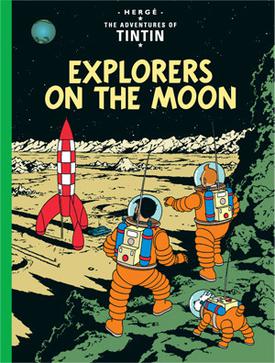
Explorers on the Moon is the seventeenth volume of The Adventures of Tintin, the comics series by Belgian cartoonist Hergé. The story was serialised weekly in Belgium's Tintin magazine from October 1952 to December 1953 before being published in a collected volume by Casterman in 1954. Completing a story arc begun in the preceding volume, Destination Moon (1953), the narrative tells of the young reporter Tintin, his dog Snowy, and friends Captain Haddock, Professor Calculus, and Thomson and Thompson who are aboard humanity's first crewed rocket mission to the Moon.
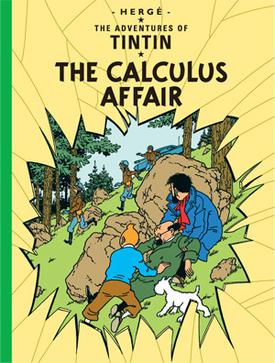
The Calculus Affair is the eighteenth volume of The Adventures of Tintin, the comics series by the Belgian cartoonist Hergé. It was serialised weekly in Belgium's Tintin magazine from December 1954 to February 1956 before being published in a single volume by Casterman in 1956. The story follows the attempts of the young reporter Tintin, his dog Snowy, and his friend Captain Haddock to rescue their friend Professor Calculus, who has developed a machine capable of destroying objects with sound waves, from kidnapping attempts by the competing European countries of Borduria and Syldavia.

Tintin is the titular protagonist of The Adventures of Tintin, the comic series by Belgian cartoonist Hergé. The character was created in 1929 and introduced in Le Petit Vingtième, a weekly youth supplement to the Belgian newspaper Le Vingtième Siècle. Appearing as a young man with a round face and quiff hairstyle, Tintin is depicted as a precocious, multitalented reporter who travels the world with his dog Snowy.
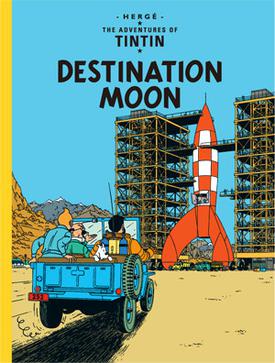
Destination Moon is the sixteenth volume of The Adventures of Tintin, the comics series by Belgian cartoonist Hergé. The story was initially serialised weekly in Belgium's Tintin magazine from March to September 1950 and April to October 1952 before being published in a collected volume by Casterman in 1953. The plot tells of young reporter Tintin and his friend Captain Haddock who receive an invitation from Professor Calculus to come to Syldavia, where Calculus is working on a top-secret project in a secure government facility to plan a crewed mission to the Moon.

The Adventures of Jo, Zette and Jocko is a Franco-Belgian comics series created by Hergé, the writer-artist best known for The Adventures of Tintin. The heroes of the series are two young children, brother and sister Jo and Zette Legrand, and their pet chimpanzee Jocko, plus their parents, Mr Legrand, Jo and Zette’s father, aerospace engineer and designer, and Mrs Legrand, Jo and Zette’s mother, housewife and Mr Legrand’s wife.

Popol Out West is a comic by the Belgian cartoonist Hergé, better known as the creator of The Adventures of Tintin series. Commissioned by the conservative Belgian newspaper Le Vingtième Siècle for its children's supplement Le Petit Vingtième, it was serialised weekly from February to August 1934. The story tells of two anthropomorphic bears, Popol and Virginia, who travel into the Wild West to sell hats, facing opposition from a tribe of hostile Native American rabbits and a criminal bulldog named Bully Bull.
Philippe Goddin is a leading expert and literary critic of The Adventures of Tintin, and author of several books on Tintin and his creator, Hergé. He was general secretary of the Fondation Hergé from 1989 to 1999.

The Unicorn is a fictional 17th-century three-masted armed French Royal Navy vessel appearing in The Adventures of Tintin, the comics series by Belgian cartoonist Hergé. The ship plays a leading role in both The Secret of the Unicorn and Red Rackham's Treasure, published in 1943 and 1944, respectively. The Unicorn also appears in the 2011 film adaptation The Adventures of Tintin: The Secret of the Unicorn.